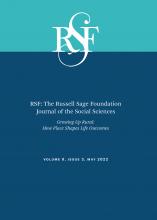Research Article
Open Access
The Geography of Rural Educational Opportunity
Jessica Drescher, Anne Podolsky, Sean F. Reardon, Gabrielle Torrance
RSF: The Russell Sage Foundation Journal of the Social Sciences May 2022, 8 (3) 123-149; DOI: https://doi.org/10.7758/RSF.2022.8.3.05
Jessica Drescher
aPhD candidates in education policy at the Stanford Graduate School of Education, Stanford University, United States
Anne Podolsky
aPhD candidates in education policy at the Stanford Graduate School of Education, Stanford University, United States
Sean F. Reardon
bEndowed Professor of Poverty and Inequality in Education at the Stanford Graduate School of Education, Stanford University, United States
Gabrielle Torrance
cAnalyst at the University of Chicago Center for RISC, United States

REFERENCES
- ↵
- Ananat, Elizabeth, and
- Christina Gibson-Davis
- ↵
- ↵
- ↵
- ↵
- Clark, Shelley,
- Sam Harper, and
- Bruce Weber
- ↵
- Crockett, Lisa J.,
- Gustavo Carlo, and
- Chelsie Temmen
- ↵
- Fahle, Erin. M.,
- Belen Chavez,
- Demetra Kalogrides,
- Benjamin R. Shear,
- Sean F. Reardon, and
- Andrew D. Ho
- ↵
- ↵
- ↵
- ↵
- Geverdt, Douglas
- ↵
- ↵
- Hancock, Christine,
- Heidi Mennega,
- Nikki King,
- Holly Andrilla,
- Eric Larson, and
- Pat Schou
- ↵
- Harbord, Roger M., and
- Julian P. T. Higgins
- ↵
- Hertz, Tom,
- Lorin Kusmin,
- Alex Marré, and
- Tim Parker
- ↵
- Holder, Kelly Ann,
- Alison Fields, and
- Daphne Lofquist
- ↵
- Housing Assistance Council
- ↵
- Johnson, Angela,
- Megan Kuhfeld, and
- James Soland
- ↵
- Johnson, Kenneth
- ↵
- Kane, Thomas J., and
- Douglas O. Staiger
- ↵
- Ladson-Billings, Gloria
- ↵
- Lichter, Daniel T
- ↵
- ↵
- ↵
- Monk, David H
- ↵
- Morrissey, Taryn W.,
- Scott W. Allard, and
- Elizabeth Pelletier
- ↵
- National Center for Education Statistics (NCES)
- ↵
- ↵
- Parker, Timothy
- ↵
- Pender, John
- ↵
- Reardon, Sean F
- ↵
- Reardon, Sean F.,
- Andrew D. Ho,
- B. R. Shear,
- Erin M. Fahle,
- Demetra Kalogrides,
- Heewon Jang, and
- Belen Chavez
- ↵
- Reardon, Sean F.,
- Demetra Kalogrides, and
- Andrew D. Ho
- ↵
- ↵
- Reardon, Sean F,
- John P. Papay,
- Tara Kilbride,
- Katherine O. Strunk,
- Joshua Cowen,
- Lily An, and
- Kate Donohue
- ↵
- Rivkin, Steven G.,
- Eric A. Hanushek, and
- John F. Kain
- ↵
- Rockoff, Jonah E
- ↵
- Roscigno, Vincent J., and
- Martha L. Crowley
- ↵
- Roscigno, Vincent J.,
- Donald Tomaskovic-Devey, and
- Martha Crowley
- ↵
- ↵
- Showalter, Daniel,
- Sara L. Hartman,
- Jerry Johnson, and
- Bob Klein
- ↵
- Tickamyer, Ann R., and
- Cynthia M. Duncan
- U.S. Census Bureau
- ↵
- Weinlein, Vanessa L
In this issue
The Geography of Rural Educational Opportunity
Jessica Drescher, Anne Podolsky, Sean F. Reardon, Gabrielle Torrance
RSF: The Russell Sage Foundation Journal of the Social Sciences May 2022, 8 (3) 123-149; DOI: 10.7758/RSF.2022.8.3.05
Jump to section
Related Articles
- No related articles found.
Cited By...
- No citing articles found.





